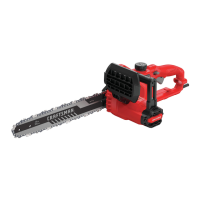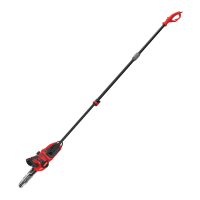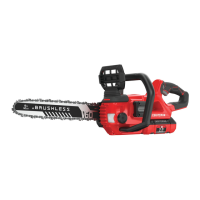10
felling cuts are to be made.
• (Figure L) Notching Undercut - Make
the notch 1/3 of the diameter of the tree,
perpendicular to the direction of the fall.
Make the lower horizontal notching cut
first. This will help to avoid pinching of
either the saw chain or the guide bar when
the second notch is being made.
• (Figure L) Felling Back Cut - Make the
felling back cut at least
2 inches (51mm) higher than the horizontal
notching cut. Keep the felling back cut
parallel to the horizontal notching cut.
Make the felling back cut so enough wood
is left to act as a hinge. The hinge wood
keeps the tree from twisting and falling in
the wrong direction. Do not cut through
the hinge.
• (Figure L) As the felling cut gets close to
the hinge the tree should begin to fall. If
there is any chance that the tree may not
fall in the desired direction or it may rock
back and bind the saw chain, stop cutting
before the felling cut is complete and use
wedges to open the cut and drop the tree
along the desired line of fall. When the tree
begins to fall remove the chainsaw from
the cut, stop the motor, put the chainsaw
down, then use the retreat path planned.
Be alert for overhead limbs falling and
watch your footing.
LIMBING
Limbing is removing the branches from a
fallen tree. When limbing, leave larger lower
limbs to support the log off the ground.
Remove the small limbs in one cut.
Branches under tension should be cut from
the bottom up to avoid binding the chainsaw
as shown in figure M. Trim limbs from
opposite side keeping tree stem between
you and saw. Never make cuts with saw
between your legs or straddle the limb to be
cut.
2 (5cm)
INCHES
DIRECTION
OF FALL
2 (5cm)
INCHES
HINGE
NOTCH
FELLING BACK
CUT
L
M
BUCKING
Bucking is cutting a felled tree or log into
lengths. How you should cut depends on
how the log is supported. Use a saw horse
(figure N) whenever possible.
• (Figure N) When using a saw horse
This is strongly recommended whenever
possible. Position the log in a stable
position. Always cut on the outside of the
saw horse arms.
Always start a cut with the chain running at
full speed.
• Place the bottom spike (22) of the
chainsaw behind the area of the initial cut
as shown in figure O.
• Turn the chainsaw on then rotate the chain
and bar down into the tree, using the
spike as a hinge.
• Once the chainsaw gets to a 45 degree
angle, level the chainsaw again and repeat
steps until you cut fully through.
• When the tree is supported along its
entire length, make a cut from the top
(overbuck), but avoid cutting the earth as
this will dull your saw chain quickly.
• (Figure P) When supported at one end
First, cut 1/3 the diameter from the
underside (underbuck). Then make the
finished cut by overbucking to meet the
first cut.
N
O
22
CUT FROM TOP
(OVERBUCK)
AVOID CUTTING EARTH
1
1
2
2nd CUT OVERBUCK
(2/3DIAMETER)
TO MEET 1st CUT
(TO AVOID PINCHING)
1st CUT UNDERBUCK
(1/3 DIAMETER)
AVOID SPLINTERING
P

